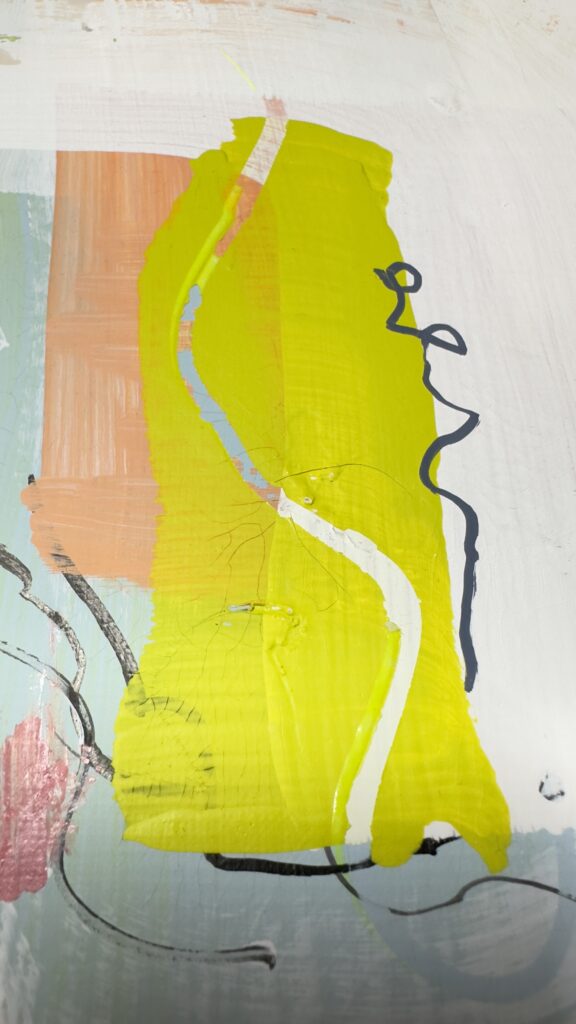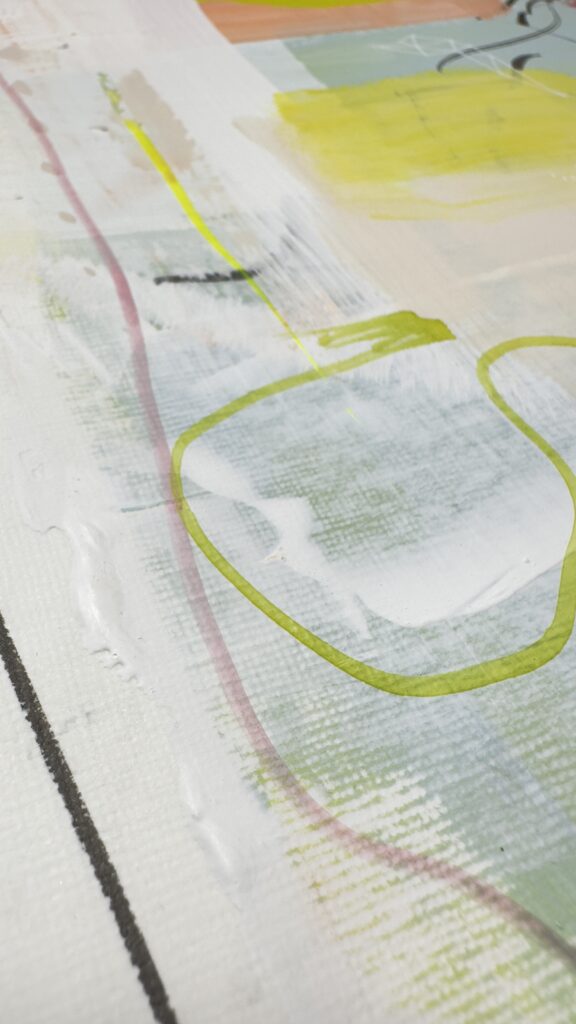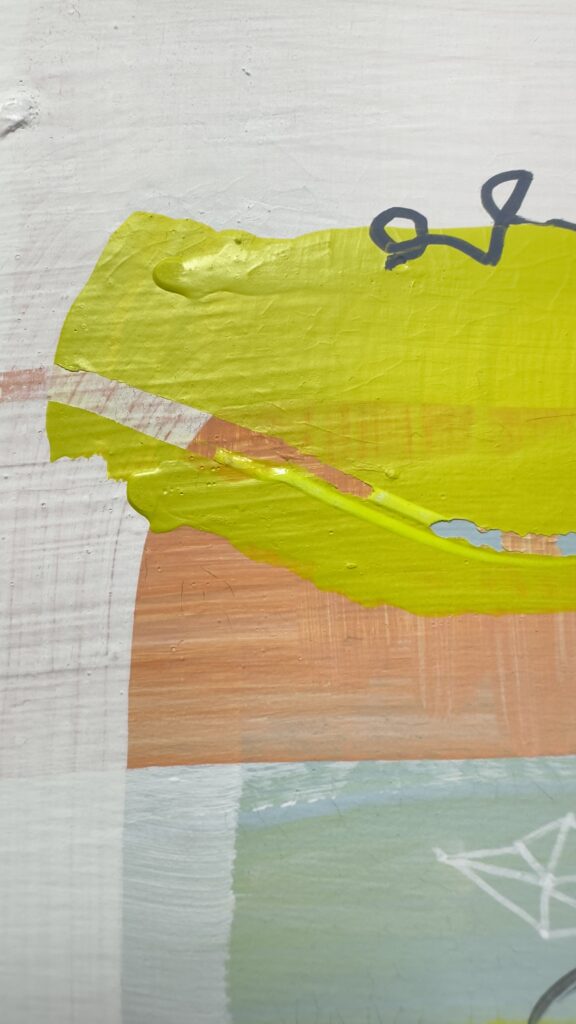Before the sun even shines, I’m already prepping my studio and my office. With a past in professional photography, my skillset proves invaluable as I set up to capture my artwork. The pieces are photographed with high-end equipment, ensuring every detail is discernible for potential fine art print collectors. These prints offer an opportunity for art enthusiasts to own a piece, especially if they are drawn to a larger representation of the work or if the original might be outside their budget.
But capturing the image isn’t just about the static visual. I often use neon uv light reactive paint and markers in my abstract gestural artworks. So, capturing the dynamism of the colors, the texture, and the unique glow is essential. Videos and images are taken to do justice to every nuance.
Once that’s accomplished, the creative process of naming the artwork begins. This is possibly my favorite step, as it encapsulates the essence of the piece. Following this, there’s the tedious yet vital task of creating an inventory number and recording the provenance. Details such as exhibitions the artwork has been part of, its storage location, and more are added. All this information is meticulously archived on my platform of choice artworkarchive.com . The system aids in streamlining the process, ensuring that no detail, however minute, is overlooked.
With the administrative work in place, I decide which artworks to list on various platforms like my personal shop and SaatchiArt ( use this link to get 15% off your first order). Decisions, decisions!
The day concludes with perhaps the most intimate act of an artist: signing the piece. It’s a personal stamp, an acknowledgment of creation.
Considering the work that goes into each piece, I’ve decided to elevate the prices of my original artworks. Rest assured, prints will remain at their current price. As I comb through my vast collection, cataloging and archiving, it’s evident that being an artist isn’t just a passion—it’s my full-time job.
In this journey, every bit of support counts. Whether you choose to bring a piece of my art into your life, follow my artistic journey, or simply share my posts, each gesture is deeply appreciated. Let’s continue to celebrate art, in all its forms.






A Life Unfolding: Gloria Vanderbilt’s Unusual Journey
Gloria’s life was long, privileged, and filled with old-world aristocratic coldness. Her existence, cushioned by wealth yet alienated from the majority, fascinated me, as did the religious dogmas that shaped her public image. She was called the “Vanderbilt child” in the press, an impersonal way to reference a living, breathing individual. The melancholy of her story was underscored by her relationships, her need for protection, and her restlessness to propel herself forward.
A Painter’s Reflection: My Connection to Gloria
As I dove into Gloria’s world, I couldn’t help but see reflections of my own life. I, too, have felt the drama and the pull of an unusual existence, without the Vanderbilt wealth. I have longed for normalcy while recognizing that my drive for more would never allow it. Like Gloria, I have been drawn to the arts, bypassing myself opportunities in acting, to find my mark in painting.
Our experiences with motherhood and inheritance ( or lack there of in my case ) also mirrored each other. Gloria’s decision to cut her mother off from her inheritance, telling her to “get a job,” echoed the words my daughter spoke to me during hard times. Both of us worked hard, driven by love and responsibility, striving to provide for those we cared about and find ourselves in the process.
The Artistic Soul: Loneliness and Connection
Perhaps the most powerful link between Gloria and myself lies in the internal loneliness that seems to fuel our artistic expression. Gloria’s lack of a concrete life plan, her struggles with identity, and her desire to connect through her art mirror my own feelings. This deep-seated, isolating sense of loneliness has become a driving force behind my work, propelling me forward through tragedy and restlessness.
Gloria’s inventiveness, her journey through love and loss, and her ability to continue living despite unbearable heartache resonates with me. Her life story, entwined with art and tragedy, is a poignant reminder of human resilience.
Conclusion: A Shared Journey
The documentary “Nothing Left Unsaid” offered me a glimpse into a life both foreign and familiar. Gloria’s childlike art, her relationships, her restless drive, and her intense longing for connection mirror aspects of my own life. As an artist, a mother, and a woman who has experienced the unpredictable tides of life, I see in Gloria a kindred spirit.
Her story inspires me to embrace the unpredictability of life, to find strength in love, and to express it all through my art. It serves as a reminder to tell those in my life that they are loved and supported, and to share that love more widely through my paintings.
This is more than a review of a documentary; it’s an exploration of the human soul, an intertwining of two lives connected by art, love, and a drive to understand and be understood.
]]>
In “Mad Men,” the advertising genius Don Draper, known for his sharp wit and creative prowess, had an affinity for abstract art. This wasn’t just a matter of aesthetic appeal; it was a subtle indication of his intellectual depth and innovative thinking. Similarly, in the groundbreaking series “Succession,” the billionaire Roy family’s home is adorned with abstract artwork, underscoring their wealth, status, and a keen eye for value beyond the material realm.
But why is it that characters like these are typically associated with abstract art? The connection might be more profound than you think.
The intrinsic beauty of abstract art lies in its openness to interpretation. Unlike other art forms, it doesn’t tell a defined, coherent story. It leaves room for imagination, allowing the viewer to dive deep into their mind and extract a meaning that resonates with them. Hence, it’s often the intellectuals, the creatives, the mavericks, who are drawn to these enigmatic pieces, their minds capable of appreciating and deciphering the layers within the abstract.
Moreover, the appreciation of abstract art requires a certain degree of cultural and artistic knowledge, often associated with a higher level of education or social status. To put it simply, buying abstract art isn’t just a matter of taste, but a show of cultural capital.
Let’s not forget the significant role of abstract art as a symbol of financial power. With famous pieces by artists like Jackson Pollock or Mark Rothko selling for millions, owning a piece of abstract art has become a status symbol—a sign of affluence. However, it’s not just about the price tag. It’s about the willingness to invest in something intangible and profound, something that holds its value in sentiment and cultural significance rather than in dollars and cents.
However, this doesn’t mean that abstract art is only for the elite. The beauty of it lies in its universality. You don’t need to have a six-figure salary or a degree in Art History to enjoy abstract art. All you need is a mindset open to exploration and the ability to appreciate the mystery and beauty of the abstract.
So the next time you see an abstract painting in a movie or on TV, remember that it’s not just a prop—it’s a statement about the character who owns it. And if you’re considering buying an abstract piece for your own home, know that you’re not just buying a piece of art—you’re purchasing a symbol of your intellectual curiosity, your appreciation for the abstract, and your individuality. Abstract art is not just about breaking patterns in the artistic world; it’s about challenging norms and conventions in the real world. It’s a badge of sophistication, intellect, and power—a testament to the complexity of the human mind.
]]>The essence of creativity often lies in its breadth rather than its depth. From the polymaths of the Renaissance, such as Leonardo da Vinci, to the interdisciplinary experts of today, we are drawn to those whose expertise spans across different fields. Yet, somewhere along the line, the concept of being a ‘jack of all trades’ has been diluted, even disparaged. So, as we appreciate interdisciplinarity in our professional lives, why does the art world still advocate for hyper-specialization?
In today’s art ecosystem, could artists potentially benefit from the ‘Renaissance’ approach of mastery in multiple domains, and could the audience embrace it too? This is not just an exploration but an open invitation for us to engage in this conversation.
But let’s start at the beginning. Back in Elizabethan England, a “jack of all trades” was a compliment, a term attributed to none other than William Shakespeare. It painted a picture of a creative force, capable of excelling in multiple areas, like a diamond with many facets. As time passed, however, this phrase evolved, simplifying to “jack of all trades, master of none”, losing the latter half of the phrase, and along with it, the essence of the original sentiment.
This evolution of thought is especially apparent within the modern art market. The market, as portrayed in a recent The New Yorker article about Larry Gagosian, one of the world’s leading art dealers, expects artists to specialize and stick to a distinct style or medium. But could this approach stifle creative growth and limit artistic expression?
As an avid art enthusiast, I often grapple with these questions. I wonder if the art market’s pressures might be inhibiting artists from exploring new domains. Like Cecily Brown, whose work has fetched millions, has expressed, there’s an intrinsic tension between the demands of the marketplace and the artist’s need for creative exploration. The incessant focus on prices can potentially confine the artistic spirit.
So, let me pose this question to you: Do we, as consumers of art, share some responsibility for this situation? Do we inadvertently encourage this trend by pigeonholing artists into specific styles or genres that we find appealing?
Reflecting on these thoughts, I’ve started to wonder – what if we broadened our perspective? What if we embraced artists who sought to diversify their work? Just as Jenny Saville, whose painting “Propped” made auction history, points out, the value of art cannot be determined by its market price alone.
Historically, many artists, such as Picasso and Da Vinci, flourished across varied artistic domains. They didn’t restrict themselves to a single style, a testament to the potential value of diversification in artistic work. But how can we encourage this kind of exploration in today’s art market?
I’d love to hear your thoughts. Do you think galleries and patrons should actively support artists in their multidisciplinary endeavors? Could we, as an audience, be more open to an artist’s evolution, celebrating their journey rather than confining them to a single style?
In an era that increasingly values interdisciplinarity, I propose we redefine our understanding of the modern-day ‘Renaissance artist’. They aren’t just masters of one but explorers of many, driven by curiosity and creativity rather than market trends. Perhaps it’s time we tune into the symphony of their varied notes, rather than expecting a monotonous tune. I welcome you to join this conversation, as we open our minds to the potential of the Renaissance artist in the modern age.
Below find ten living artists who have demonstrated their creativity in different mediums and styles, and who have evolved throughout their careers:
- Yoko Ono – Known as a multidisciplinary artist and peace activist, Ono has delved into conceptual art, performance art, filmmaking, and music over her career. Website
- David Hockney – A versatile artist who’s experimented with painting, drawing, printmaking, photography, and digital art. His style has evolved from abstract to realism, showcasing a wide variety of techniques and subjects. Website
- Anish Kapoor – His work ranges from massive outdoor installations to highly polished mirrored surfaces and raw, primary forms. He uses various materials including stone, wax, and stainless steel. Website
- Ai Weiwei – Known for his critical political art, Ai Weiwei uses a variety of mediums including sculpture, installation, architecture, and photography. Website
- Cindy Sherman – While photography remains her primary medium, Sherman’s style has significantly evolved over her career. She’s explored themes such as female stereotypes, society’s portrayal of women, horror, and even clowns. Website
- Marina Abramović – Known as the “grandmother of performance art”, Abramović has also produced works in sound installations, sculpture, video work, and photography. Website
- Damien Hirst – Controversial and multidisciplinary, Hirst’s work ranges from sculpture and installation to painting and drawing. He’s famous for his series of artworks in which dead animals are preserved in formaldehyde. Website
- Takashi Murakami – Known for his bold anime-inspired “Superflat” style, Murakami’s work spans from painting and sculpture to fashion, merchandise, and animation. Website
- Olafur Eliasson – Eliasson is known for his large-scale installation art, which often has an interactive component, as well as his work in painting, sculpture, photography, and film. Website
- Kiki Smith – Smith works in a variety of media including sculpture, printmaking, and textiles. She explores themes of feminism, human bodily functions, and human rights in her varied and evolving body of work. Website
These artists exemplify how experimentation across mediums and styles can result in a diverse and dynamic body of work.
]]>